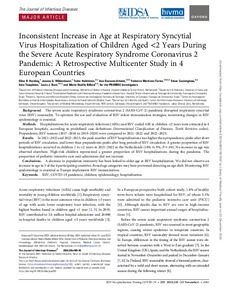Inconsistent Increase in Age at Respiratory Syncytial Virus Hospitalization of Children Aged <2 Years During the Severe Acute Respiratory Syndrome Coronavirus 2 Pandemic: A Retrospective Multicenter Study in 4 European Countries
Harding, Eline R; Wildenbeest, Joanne G; Heikkinen, Terho; Dacosta-Urbieta, Ana; Martinón-Torres, Federico; Cunningham, Stev; Templeton, Kate; Bont, Louis J; Billard, Marie-Noëlle; PROMISE investigators
https://urn.fi/URN:NBN:fi-fe2025082791491
Tiivistelmä
Background: The severe acute respiratory syndrome coronavirus 2 (SARS-CoV-2) pandemic disrupted respiratory syncytial virus (RSV) seasonality. To optimize the use and evaluation of RSV infant immunization strategies, monitoring changes in RSV epidemiology is essential.
Methods: Hospitalizations for acute respiratory infections (ARIs) and RSV-coded ARI in children <2 years were extracted in 4 European hospitals, according to predefined case definitions (International Classification of Diseases, Tenth Revision codes). Prepandemic RSV seasons (2017-2018 to 2019-2020) were compared to 2021-2022 and 2022-2023.
Results: In 2021-2022 and 2022-2023, the peak number of RSV hospitalizations was higher than prepandemic peaks after short periods of RSV circulation, and lower than prepandemic peaks after long periods of RSV circulation. A greater proportion of RSV hospitalizations occurred in children 1 to <2 years in 2021-2022 in the Netherlands (18% vs 9%, P = .04). No increase in age was observed elsewhere. High-risk children represented a greater proportion of RSV hospitalizations during the pandemic. The proportion of pediatric intensive care unit admissions did not increase.
Conclusions: A decrease in population immunity has been linked to older age at RSV hospitalization. We did not observe an increase in age in 3 of the 4 participating countries. Broad age categories may have prevented detecting an age shift. Monitoring RSV epidemiology is essential as Europe implements RSV immunization.
Kokoelmat
- Rinnakkaistallenteet [27094]
